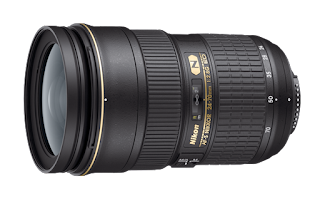The $1,800 Nikon 24-70 f2.8: pride of measurbators, but actually lousy for low-light photography.
There are two types of photographers: those who like to take pictures and those who like to show off their equipment. Of course, each group does occasionally stray into the other's territory but, for the most apart, each camp tends to stay with its own beliefs.
For those people who like to show off equipment, the constant f2.8 zoom is their most prized possession. Always marketed toward professionals (and priced for them, too), these lenses are tough, equipped with the latest technology, and often impressive to look at. The real funny part about such lenses (besides the fact that non-pros are willing to pay for them) is the fact that, in the big picture (sorry), they're not that fast despite always being marketed for their fast optics.
In photography, each f-stop represents the doubling/halving of exposure time. In terms of focal ratios, the common f-stops are: f1.4, 2, 2.8, 4, 5.6, 8, 11, and 16. So, with each stop slower (larger numbers are slow, small apertures), the exposure time is doubled. Example: f2.8 (the zoom best) is a stop faster than f4, thus a f2.8 lens will require half the exposure time of a f4 optic in a given situation. So, if a f2.8 lens requires a 1/50th second shutter speed, the f4 will require 1/25th second (twice as long) for the same result. In some cases, f2.8 can make the difference between hand holding and needing a tripod.
Now, consider this: f2 or faster lenses.
The conventional rule of thumb for optical design is this: twice the glass means twice the price. In theory, then, a f2 optic should always be as twice as expensive as a f2.8 model. However, with the advent of zooms, this is not always the case, often far from it. While primes are simple designs requiring comparatively few glass elements, zooms are complex affairs requiring a lot of engineering and glass. Result: slow zooms are often more expensive than faster primes.
Example: Nikon's top-notch professional FX f2.8 zoom, the 24-70, costs around $1,800. Now, Nikon's top-notch FX 50mm f1.4 prime, the 50 AF-S, costs around $450 despite the fact that it lets in 4 times as much light (f1.4 is 2 stops faster-hence 4 times as much light) as the zoom. Suddenly, people looking to buy the expensive 24-70 for its “fast” optics look pretty stupid, don't they? Want something funnier? If you're willing to sacrifice full time manual focus, you can snag the 50 f1.8D, which still lets in over twice as much light as the 24-70) for around $135 (not even 1/12th the price of the 24-70).
Yes, the 24-70 has its benefits, namely weather resistance (though it is by no means waterproof) and the flexibility of a zoom, but, for those looking to shoot in low light, the fast primes are the way to go as they will always do the job better for a fraction of the cost of a zoom.
Now, how about some pictures?
Recently, there was a clear night (amazing in itself in Northeast Ohio this time of year), a bright Moon, and a glaze of ice atop the melting snow (from the Groundhog Day ice storm). Result: whatever lights there were reflected atop the glazed show, which took on the appearance of glass. Needless to say, picture opportunities abounded.
So, taking my D700 and 50 f1.4D (the middle of the road 50) out into the night, I captured some amazing shots of the warm mid-winter night, hand-held! Could your expensive f2.8 zoom do this? I don't think so!
Humble requests:
If you found this informative (or at least entertaining), help me pay my bills and check out my Examiner pages for photography and astronomy for more great stuff.
If you think this was cool, why not tell a friend?
For something even better, follow this blog.





















No comments:
Post a Comment